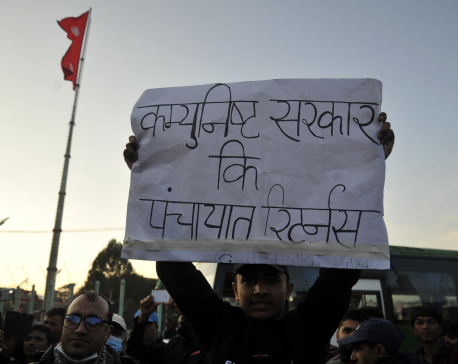
OR
Dengue dangers are looming once again, this time from Dharan. Doctors at BP Koirala Institute of Health Sciences (BPKIHS) have identified 32 more dengue patients on Tuesday alone. On Monday, 35 dengue patients were admitted to this hospital. According to the report since May 14, the number of dengue patients in Dharan has reached 173. Health professionals have warned that if this number continues to rise this way, it will be very difficult to bring the situation under control. Local authorities have announced to start a campaign to search and destroy the eggs and larvae of the dengue carrier mosquitoes in each house at the affected locality. Such measure should have been taken much earlier. Nepal’s health institutes need to be alarmed about dengue not only because it is lethal but also because dengue epidemic has emerged as a public health hazard in Nepal many times. Only in October last year, 22 cases of dengue were reported in Pokhara. This shows what was thought of as a disease that usually spreads during the monsoon has started to surface in the winter as well and even in the hills.
This infectious disease is usually contracted from mosquitoes belonging to Aedes Aegypti genus. Symptoms manifest in mild fever to incapacitating high fever, severe headache, pain in muscles and joints, and rashes in the skin. According to Epidemiology and Disease Control Division, earliest cases of dengue were detected as early as 2005. Though most initial cases had travel history to neighboring country India, indigenous cases have also been reported. According to the Center for Disease Control and Prevention (CDC) of the US, around 400 million people are affected by dengue every year. Though dengue is said to cause seldom deaths, many people around the world have succumbed to it. According to the World Health Organization (WHO) report, in 2015, 2.35 million cases of dengue were reported in Americas alone, of which 10,200 cases were diagnosed as severe dengue causing 1,181 deaths. And in 2016, 1032 dengue deaths were reported in the region again.
Dengue is a preventable disease. Preventing mosquitoes from accessing egg-laying habitats, covering, emptying and cleaning of domestic water storage containers on a weekly basis, applying appropriate insecticides to water storage outdoor containers are some simple solutions. But in Nepal, we often rise to action when the cases are reported and effects felt. In Dharan, for example, health professionals and community members took to destroying the eggs and larvae of dengue spreading mosquitoes only after cases started to be reported with troubling frequency. Our health facilities are often not equipped with required diagnosis machines to treat the patients. Thus while it is imperative for the government to work on prevention methods it needs to be equally alert and be able to reach out to the affected communities immediately after cases are reported. As monsoon is looming, more cases of malaria, viral fever and dengue are sure to emerge. While public awareness can help people keep themselves safe, our public health mechanisms also need to be kept at alert position. Nepal has had bad record of containing epidemic diseases. Government’s failure to mobilize health professionals and provide medicines to the communities affected by cholera led to death of around 350 people in Jajarkot in 2009. Outbreak of cholera and other infectious diseases poses big public health risks in Nepal. Nobody should suffer or lose their lives to these preventable diseases.
You May Like This

For Congress, an opportunity to rise
At a time Nepali Congress has been criticized for failing to play the role of constructive opposition in the parliament... Read More...

Heed public outrage
It’s deeply troubling that the government of K P Sharma Oli is displaying authoritarian tendencies through a number of steps... Read More...

CIAA, keep the momentum
Commission for the Investigation of Abuse of Authority (CIAA) has upped its ante in investigating cases of corruption and irregularities. Read More...







Just In
- NRB to provide collateral-free loans to foreign employment seekers
- NEB to publish Grade 12 results next week
- Body handover begins; Relatives remain dissatisfied with insurance, compensation amount
- NC defers its plan to join Koshi govt
- NRB to review microfinance loan interest rate
- 134 dead in floods and landslides since onset of monsoon this year
- Mahakali Irrigation Project sees only 22 percent physical progress in 18 years
- Singapore now holds world's most powerful passport; Nepal stays at 98th











Leave A Comment